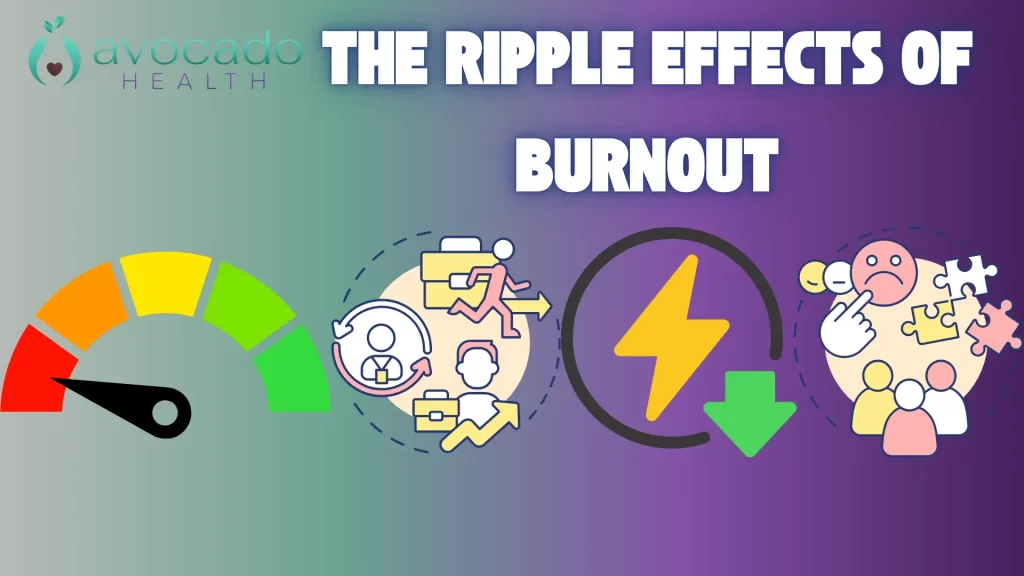Dad of 5. CEO & Co-Founder of Avocado Health. Former HealthTech & FinTech Founder. Passionate about empowering families and driving change in parenting and child development.
How Much Does Burnout Cost the Workplace?

Why Do Employers Need to Step Up and Help Working Parents Avoid Burnout?
An eye-opening 65%of working parents report feeling burned out. That’s a significant number, and it’s something employers simply can’t afford to ignore. In today’s fast-paced world, burnout is becoming an all-too-common problem—especially for parents who are trying to balance their careers with family life. Companies support working parents to address these challenges, leading to improved employer branding, higher employee retention, and increased productivity.
The High Price of Working Parent Burnout

Burnout is more than just a problem for employees—it’s a huge cost for employers too. Studies show that disengaged workers can cost businesses around $4,680 for every $10,000 in salary, primarily due to lost productivity.
On top of that, when employees leave due to burnout, replacing them can cost a company up to twice their annual salary. These financial strains add up quickly, making it clear that ignoring employee burnout is not an option.
Furthermore, low worker engagement doesn’t just hurt one company—it’s a global issue. The economic toll of disengaged workers leads to an eye-popping $8.9 trillion loss in global GDP.
This highlights just how far-reaching burnout’s impact can be, and why it’s in every employer’s best interest to prioritize the well-being of their teams. Supporting working parents isn’t just the right thing to do—it’s a smart business decision. When your team thrives, your business thrives.
So, why are working parents particularly vulnerable to burnout? And what can companies do to step in and help? Let’s take a closer look at why this issue matters so much for employers, how it impacts your bottom line, and the steps you can take to help the working parents who are vital to your company’s success.
What is Burnout?

Burnout isn’t just about feeling wiped out after a busy day—it’s that deep, draining exhaustion that leaves you mentally, emotionally, and physically spent. For working parents, the never-ending balancing act between career and family can push them to the brink, making burnout more than just a possibility—it becomes a reality.
This kind of exhaustion can leave employees feeling disconnected, unmotivated, and less effective at work. It affects not only their performance but also their overall well-being and job satisfaction. The good news? By understanding the root causes of burnout, employers have a powerful opportunity to step in and make a difference, helping to prevent it before it takes hold.
Why Are Parents More Likely to Burn Out?
Balancing Work and Childcare Responsibilities

Trying to juggle a demanding job with family life while raising kids can feel like walking a tightrope. Parents are constantly being pulled in different directions—answering emails while keeping an eye on the kids, attending meetings while managing household chores.
Parents with younger children face unique challenges as they require more supervision, making reliable childcare essential for maintaining focus on work tasks.
The stress of constantly switching between roles can be exhausting, and without the right support, it’s easy for that stress to snowball into burnout. It’s no surprise that many parents feel overwhelmed trying to manage it all!
Managing the Mental Load and Feeling Overwhelmed
Working parents frequently grapple with feelings of guilt and inadequacy, worrying that they’re not fully committing to either their careers or their children. This mental load can be overwhelming, leading to stress, anxiety, and burnout.
The Emotional and Physical Toll of Parenting

Parenting, whether they’ve got toddlers demanding their attention or teens navigating their own challenges, takes a real emotional and physical toll. It’s the never-ending cycle of worrying about kids’ needs, making sure they’re healthy, happy, and thriving. When you add the pressure of work on top of that, it can feel like there’s no break. The stress can quickly pile up, and without the right support—either at home or work—it’s easy for parents to feel completely drained. It’s a lot to carry, and sometimes it just becomes too much to handle alone.
Feeling Unsupported at Work

When companies don’t support employees, especially parents, they can start to feel like they’re facing their challenges alone. If companies aren’t offering flexibility or showing understanding, it can make balancing the demands of both work and family feel impossible. This lack of support can pile on even more stress, leaving employees feeling overwhelmed and, eventually, burned out. A little flexibility and empathy can go a long way in helping parents manage both roles without feeling like they’re constantly falling short.
Overcoming Stereotypes and Biases in the Workplace

Working parents, particularly mothers, still face stereotypes and biases in the workplace. The “motherhood penalty” is a real challenge many working moms face, where they’re often unfairly seen as less committed or capable than their colleagues without kids.
This bias can hold working moms back in their careers, even though they’re juggling so much more behind the scenes. It not only stifles their growth at work but also fuels feelings of inadequacy and burnout.
The Stigma Around Family Time

Sadly, there’s still a stigma in many workplaces when it comes to taking time off for family reasons. Many parents worry that asking for time off to attend a child’s doctor appointment or school event will make them look less committed or hurt their chances for career growth.
This fear adds even more pressure, creating a cycle of stress that only leads to burnout. When companies normalize family time and make it clear that taking care of loved ones doesn’t equal falling behind, parents feel more supported—and stress levels can drop significantly.
How Burnout Affects Your Workplace

Approximately 40% of the total U.S. workforce are considered working parents, which means they’re managing both childcare responsibilities and their professional duties. When workers, particularly working parents, are overwhelmed and mentally drained, it can severely impact both their performance and the overall business.
The ripple effects of burnout can undermine a company’s growth and success. Here’s a closer look at how burnout manifests and its impact on your workplace:
1. Lower Productivity

When parents are burned out, their productivity takes a hit. They struggle to focus, miss deadlines, and can’t perform at their best. This isn’t just about a bad day—it leads to missed opportunities and can slow down the company’s overall growth. When workers aren’t at their best, neither is the business.
2. High Employee Turnover

Burnout doesn’t just lead to unhappy Workers—it often drives them to leave. This creates a costly cycle for companies, from recruitment expenses to the loss of experienced talent. Replacing a burned-out employee can be expensive and time-consuming, both financially and in terms of company knowledge.
3. Reduced Creativity and Decision-Making

The mental toll of burnout affects employees’ ability to think clearly and make good decisions. It also stifles creativity, which is crucial for problem-solving and innovation. This can leave a team stuck, unable to adapt and respond to new challenges, which ultimately slows down progress in the workplace.
4. Impact on Company Culture
Burnout doesn’t just affect the individual—it can spread like wildfire through a team. When employees see their colleagues struggling, it lowers morale and creates a negative, unproductive atmosphere.
A workplace where burnout is the norm becomes a tough place to thrive, making it harder to attract and keep top talent. No one wants to work in a culture where burnout is accepted, and that can have a long-lasting impact on the overall success of the company.
How Employers Can Help Prevent Burnout in Working Parents

Employers have the power to make a huge difference in the lives of working parents. By recognizing the unique challenges parents face and offering support, businesses can create a more balanced, engaged, and productive workforce. To effectively prevent burnout and ensure working parents thrive, employers can take several actionable steps:
1. Offer Flexible Work Arrangements
Flexibility is a game-changer for parents. Allowing them to adjust their schedules or work from home can make a huge difference in balancing family and work responsibilities.
When parents can manage family commitments without feeling like they’re sacrificing their job performance, it eases a lot of stress. Flexible work options help parents maintain that delicate work-life balance, ultimately leading to a happier, more productive team.
2. Create a Supportive, Understanding Culture
Workplaces that truly value employees’ personal lives foster a positive and supportive culture. This means being open to flexible hours, offering resources for managing workloads, and showing understanding when life happens.
When employees feel that their personal needs are respected, they’re much more likely to feel engaged and less likely to experience burnout. A little empathy goes a long way!
3. Tackle biases
Employers can tackle workplace biases by fostering an inclusive, supportive environment where all employees, regardless of their caregiving responsibilities, feel valued and empowered.
Promoting diversity, equity, and inclusion is key to overcoming these stereotypes. Employers can implement training programs to raise awareness about unconscious biases and encourage a culture of respect and understanding. Policies that support work-life balance, such as flexible work arrangements and parental leave, also play a crucial role in leveling the playing field.
4. Provide Mental Health Resources
Burnout often goes hand-in-hand with mental health struggles like stress and anxiety. Employers can make a big impact by offering access to mental health support, such as counseling services, workshops on stress management, and programs to boost mental well-being.
These resources not only help employees cope but also show that their mental health is just as important as their job performance, helping to prevent burnout before it starts.
5. Implement Parental Support Programs
Working moms often face unique challenges balancing work and family life. Tailored programs designed to support them can make a big difference.
Offering coaching to help manage family and work responsibilities, along with educational resources for children’s needs (like ADHD support or tips for handling school struggles), can lighten the load. These programs provide practical help, reducing the stress of trying to juggle it all on their own.
6. Employee Resource Groups (ERGs)
ERGs can play a crucial role in reducing burnout and improving employee engagement. These supportive networks for employees sharing common social identities, such as parents or caregivers, enhance engagement, career development, and professional networking while addressing specific employee needs and advocating for workplace policies that foster inclusivity and support for working parents.
7. Recognize and Appreciate Parent Employees
Sometimes, the simple act of acknowledging a parent’s hard work can mean the world. Whether it’s celebrating their accomplishments or offering small rewards for going above and beyond, recognition shows parents they’re valued.
Feeling appreciated not only boosts morale but also motivates employees to bring their best selves to work. When parents feel supported and recognized, they’re much more likely to stay engaged and productive.
How to Measure Success

Measuring the success of your efforts to reduce burnout doesn’t have to be complicated. You can track employee satisfaction through surveys, monitor productivity levels, and keep an eye on turnover rates.
If your burnout prevention strategies are working, you’ll likely notice improvements in employee well-being and overall company performance. Happy, supported employees translate to better outcomes for the business—everyone wins!
How Avocado Health Empowers Employers to Support Working Parents
Avocado Health makes it simple for employers to support their teams with Accessible, Personalized, and Impactful Parent coaching — an AI-powered tool that addresses parents’ concerns, tracks child development, and creates personalized care plans.
By providing this valuable resource, employers can help ease parents’ stress, boost family well-being, and even lower medical claims costs.
Supporting working parents in this way not only leads to healthier families but also creates a more engaged, loyal workforce that’s ready to thrive both at home and at work.
Conclusion
As more families rely on dual incomes, it’s essential for employers to understand the unique challenges that working parents face. By offering flexible schedules, mental health resources, and parental support programs, companies can create an environment where parents can thrive both at work and at home.
When working parents feel supported, they’re more engaged, productive, and loyal to their company. This support isn’t just beneficial for the employees—it’s a smart investment for the business. Happier, supported employees lead to improved productivity, lower turnover, and a stronger company culture.
It’s time to make the well-being of parent employees a top priority.

